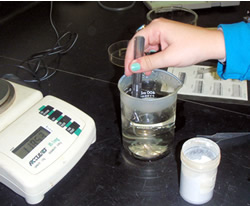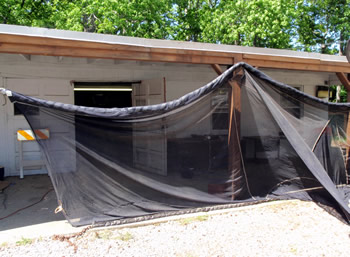 
| A Day In the Life Of a Marine Fisheries Hourly |
|
by Gerald Wilders, Hourly Fisheries Technician
Bureau of Marine Fisheries
May 18, 2016
Other articles in this series:
A Day Spent Gill Netting for River Herring
A Day With Glass Eels
A Day On the Delaware Bay Trawl
A Day on a Recreational Fishing Survey Site Assignment
A Day in the Chem Lab: Aging Weakfish, Atlantic Croaker, and American Eels
A Day on the Bay: On the Hunt for Yellow Eels
A Day On the Ocean Trawl
A Day On the Delaware River
A Day At a Fishing Tournament
A Night On the Horseshoe Crab Survey
An hourly with the Bureau of Marine Fisheries works at the Nacote Creek Research Station, located two miles north of Smithville on Rt. 9 in Galloway Township. This facility has a few buildings, the first of which is the main office. Here marine licenses are issued, the public can get information, and is the place where an hourly spends their day.
|
The next building is the wet lab, which is where hourlies do any messy work like cutting up fish or taking biological samples from fish. These fish that are processed are from the Atlantic Coastal Cooperative Statistics Program, the ocean trawl or other Bureau surveys, or tournament sampling. The last building is the chem lab, which is where chemicals to preserve fish and prepare aging samples are stored, and where we process scales and otoliths for aging.
One of the surveys that involves a good deal of lab time is the glass eel survey which provides data on how many eels are migrating upstream each winter. Baby American eels are collected in a fyke net and then brought to the lab for processing. A total weight of all eels caught is taken, and then a sub-sample of 60 eels is used where each is individually weighed and measured.
The day starts when you view the assignment board with all hourlies names. Under each name is a list of assignments and a due date depending on how urgent each one is. You can't miss it and are anxious to see what the day will bring; there are countless possibilities.
|
|
First, there is proofreading data entries, making sure that there are no errors and the data is accurate. This is tedious work and requires your total focus. The original and final entries are verified and any discrepancies are highlighted, notations are made, and necessary corrections are completed.
The final proof of the data sets can involve scanning hundreds of pages of documentation, and accuracy is paramount. Validating the accuracy of data that is entered into the computer is important because this is the data that will be used in stock assessments of various species. Proofing is not the most sought-after assignment; however, it is invaluable to our research.
|
|
Another assignment is biological sampling of the fish that were obtained from the ocean trawl, seine surveys, or fishing tournaments. The sample can vary from a whole fish to just the head. The main objective is the removal and processing of the otoliths. Otoliths are small bones located near the ear of the fish which allow us to assess the age of the fish.
This is a very delicate process. After the otolith is extracted, it is mounted onto a microscope slide in our ageing lab. Counting the rings on the otolith allows us to determine the age of the fish (similar to counting the rings of a tree). Occasionally you will remove some scales to assist with determining the age, and when possible, you define the sex of the fish as male or female.
There is also equipment maintenance and cleaning which, at times, can be very challenging. Given the proximity of the lab to the bay, you might encounter biting flies, mosquitoes, and various other insects buzzing around. Heat and little shade attract the most interesting creatures. On Fridays, the vehicles are cleaned, nets are checked for damage and equipment is repaired.
|
Your day goes quickly. Your assignments are varied and never boring. You stay focused and enjoy the challenges. But tonight you rest. Tomorrow's job duties just might involve a long field day.
Click on the links below to learn more about experiences in other Bureau of Marine Fisheries programs:
A Day On the Ocean Trawl
A Day On the Delaware River
|


